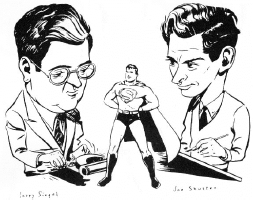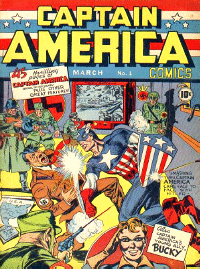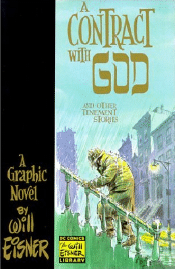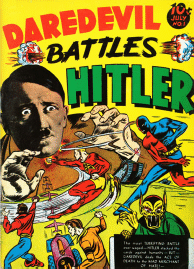Real Kavaliers & Clays
Because Kavalier & Clay is based on the history of the Golden Age of comic books, it should come as no surprise that the two heroes of the novel were inspired by several real-life comic creators. Here are a few of them.
Jerry Siegel and Joseph Shuster
 The heart of Kavalier & Clay can be traced to the creators of Superman. The two Jews were extremely young when they created their character (17 and 19 respectively). At first, no one wanted the concept, but eventually they managed to convince National Publications to publish it. When America entered World War II, Superman became a war hero who combatted Nazis overseas. Unfortunately, the two, like Kavalier and Clay, never saw the riches they deserved, and the two went unrecognized for several decades afterward.
The heart of Kavalier & Clay can be traced to the creators of Superman. The two Jews were extremely young when they created their character (17 and 19 respectively). At first, no one wanted the concept, but eventually they managed to convince National Publications to publish it. When America entered World War II, Superman became a war hero who combatted Nazis overseas. Unfortunately, the two, like Kavalier and Clay, never saw the riches they deserved, and the two went unrecognized for several decades afterward.
“But as far as the inspiration for this book, it was reading about Joe Shuster and Jerry Siegel, the creators of Superman, and how they sold the rights to the character to DC Comics for $100.00,” said in a fall 2000 interview with Failbetter.Com. “That’s not what my book is about, but it was the combination of wild imagination, male partnership, popular art, and commercial failure that resonated, and got me started.”
“I was thinking, too, of Superman and his fortress of solitude,” he told Powells.Com in October 2000. “The Superman story is one of the underlying threads of the story, coming from another planet, leaving his parents and his world that got blown up behind. He comes to this other world and he has to reinvent himself. Again, it felt natural, even though I’d been working really hard trying to come up with something.”
 Joe Simon and Jack Kirby
Joe Simon and Jack Kirby
Although both creators went on to create several comic book characters over the decades, Chabon mainly borrowed from their work on Captain America. Both were Jews and were devastated about the news overseas. They created Captain America months before America had entered the war. Steve Rogers was a weak, blond-hair boy who, with a special secret-syrum, was able to become the perfect American. Sent overseas, Captain America took on the Axis powers directly. In fact, the first issue features a cover similar to that of the fictional Amazing Midget Radio Comics #1, in that both Captain America and the Escapist punch Hitler.
“Comic books went to war before the United States did,” Chabon said in an October 2001 interview with Commonwealth Club of California. “Captain America dates from, I believe, May 1941. No villain was up to Superman. Kryptonite, in a way, is a substitute for Hitler, because Hitler was the ultimate villain. They fought the Japanese and demonized them, but this was what superheroes were made for. Comic book covers from the period are superheroes punching out U-boats, and tying anti-aircraft guns into knots. You have to remember that for the first several years of the war, it wasn’t going that well; it looked as though there was a good chance that the Allies might not win. There was a lot of very violent, potent, wish fulfillment going on there, and it did get expressed in very unattractive jingoistic, racially-offensive ways.”
Chabon recognized Jack Kirby’s unspoken contribution to Kavalier & Clay in his author’s note. “Finally, I want to acknowledge the deep debt I owe in this and everyhing else I’ve ever written to the work of the late Jack Kirby, the King of Comics.”
He went further in a New York Times article published August 27, 2003. “He could make the comics panel seem too small to contain the stories he was telling,” he said. “What I loved about him then, and continue to admire about him now, was that sense of the inexhaustibility of his imagination in every issue of whatever comic he happened to be working on. He worked all over the place his entire career and would just fill each one with 15 great ideas for a story and just push them all into the same book together. And then the next issue would come out, and he’d have 15 more.”
He went on to directly connect Kirby to Kavalier. “Especially when there’s a description of the kind of battle scenes that Joe Kavalier draws,” he said. Kirby later created Mister Miracle, an escape artist like Kavalier. “I don’t think it’s any accident that at this point in their history the entire Marvel universe and the entire DC universe are now all pinned or rooted on Kirby’s concepts.”
“But it worked both ways,” he said, “because Kirby was a huge movie fan. And his comic books are sometimes subtly, sometimes very blatantly borrowing from the movies that he loved. There was always this very strong element of that Warner Brothers, George Raft, John Garfield, Jimmy Cagney gangster stuff going through all of the books. And there’s all the Universal horror movie stuff he kept going back to over and over. You can just tell the influence of movies was very, very heavy on him.”
 Will Eisner
Will Eisner
Perhaps the most important comic book artist ever, Will Eisner was the creator of The Spirit, a comic about detective Danny Colt who fakes his death in order to take on the role of a crime fighter. Eisner seperated himself from most comic book artists at the time in that he saw the medium as a means for artistry. His panels were not confined to being evenly-divided squares; often characters and sounds would “hang” outside of panels. In 1978, he became the father of the “graphic novel” with his “A Contract with God,” His artistic abilities can be said to be the inspiration for Kavalier after he sees Citizen Kane.
“The only thing I would say about him [Kavalier] that I really did draw from an actual creator is that I gave him Will Eisner’s rather surprising and unshakable faith in the medium of comic books,” Chabon told the The Onion A.V. Club in November 2000. “That was rare at the time. In fact, I think Eisner was unique in feeling from the start that comic books were not necessarily this despised, bastard, crappy, low-brow kind of art form, and that there was a potential for real art. And he saw that from the very beginning, which was very unusual, and I took that quality and gave it to Joe Kavalier. I think that was the only direct borrowing I really did.”
Kavalier and Eisner also share their unique vision of comics as an artform. “That makes Joe pretty unusual among comic book artists of his time,” Chabon told Powells.Com in October 2000, “though there were a couple, the foremost among them being Will Eisner, a brilliant artist and a very talented storyteller. He’s the guy who created The Spirit. Right from the beginning, he saw comics as art. He didn’t have any compunction about it. He wasn’t apologetic. He didn’t have that ‘yeah, sorry, I draw comics’ kind of attitude that almost every other artist at the time did.”
But Eisner also helped confirm the link between the golem and superheroes during an interview with Chabon, according to an August 2000 Publisher’s Weekly. “He had a very rich perspective on this period, because he was not only an artist and a writer, but also a businessman–the only creator of his time who was cagey enough to hold on to the rights to the character he created. At one point, I asked him why so many of the young men in the business in the late ’30s and ’40s were Jews. And he gave, I guess, the standard answer–that the opportunity was just there. That if you were a young Jewish kid who wanted to be an artist, the more respectable forms of commercial art, illustration, advertising art–all those fields were closed to you at the time. But comics would take you.
“But then he stopped and he said, ‘But I do think there’s something in the Jewish storytelling tradition that’s exemplified by the golem, this idea of an imaginary champion that is going to come along and right all wrongs for an oppressed people.’ And that totally astonished me, because I had already written the golem into the book, even though I had only written 70 or 80 pages. I intuitively knew there was going to be some connection between the golem and the superhero. And to hear this pioneering creator articulate this same idea was a magic moment.”
 Jim Steranko
Jim Steranko
Steranko is almost the direct influence for Kavalier. Back in the 1960’s, Steranko did his most amazing comic work in Nick Fury: Agent of S.H.I.E.L.D. But before he was an artist, he was a professional escape artist. What’s more, his stint as an escape artist became the inspiration for Jack Kirby’s Mister Miracle.
Chabon later commented on the link between Kavalier and Steranko in a letter response in Wizard #122 [Note: the letter came from Nate Raymond, the operator of this website]. “I was westling with the question of how to get my character of Joe Kavalier out of Nazi-occupied Prague when I read an article about Steranko’s career as an escape artist,” he said. “So both Kavalier and the Escapist share the same inspiration as Kirby’s Mister Miracle.”
So sure was the tie between the fictional and real artists that a meeting between Chabon and Steranko was held at Lee Comics in December 2002. “I would never have written Kavalier and Clay without [Jim Steranko’s] History of Comics. It is the standard history,” Chabon said at the event according to Wellred Press. “When I first read it in 1970 was when I discovered that comics had a history…I was mind blown by [Steranko’s] body of work. The October 1995 Comic Book Marketplace issue has a detailed account of Steranko as a performing escape artist. Up until I read that, I had heard it but never knew how seriously to take that.”
Although Steranko may have formed the basis of Kavalier, his actual escapes never made it into the book, according to Chabon’s Steranko section on his website. “In October 1964, STERANKO (one senses that he might like it written thus) produced a special number of Genii, The Conjuror’s Magazine, dedicated to Houdini. In it he revealed, in startlingly generous detail, many of the secrets of the liberationist’s art. To my eternal sorrow, I learned of the existence of this remarkable issue when it was too late to be of assistance to me in writing The Amazing Adventures of Kavalier & Clay.”
“I know how they would have delighted the imagination of Joe Kavalier,” he says.
 Charles Biro
Charles Biro
Remember that amazing jam-session in Kavalier & Clay where a bunch of artists gathered together in a loft to create Amazing Midget Radio Comics #1? Well, it really happened!
It was 1941, and Charles Biro was in a pickle. Daredevil Battles Hitler had seen huge sales and a follow-up seemed inevitable. Biro’s editor, Lev Gleason of Comic House, had given him only a weekend to produce the 64-page Daredevil #2 comic book. Knowing his limits, Biro brought creators Jerry Robinson, Bernie Klein, Mort Meskin, George Roussos and others on-board to finish the entire issue on-deadline. Not only did the issue contain a Golden Age Daredevil story, but it also contained the first appearance of “London” and “Blackout” in their own stories.
“It was a weekend that captured an era,” wrote Gerald Jones, author of Men of Tomorrow: Geeks, Gangsters and the Birth of the Comic Book. “Commerce, luck, and youth had never come together so perfectly to create a moment so evanescently American. It paid off, too. Oh, the comic book they made that weekend was a mess. But it was loud and colorful and full of fighting heroes. And here and there, from the seediness and haste, emerged those moments of unannounced beauty–a perfect line, a living figure, a composition of nearly accidental grade–that are so heartbreaking and so liberating in junk culture.”
Joe Cavalieri
I doubt Chabon meant for this, but I find it a funny coincidence that a former Superman editor has basically the same name as Chabon’s literary hero. Just thought I’d point that out for kicks.